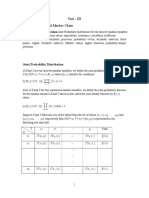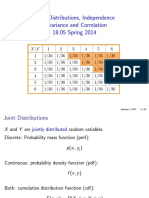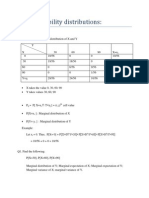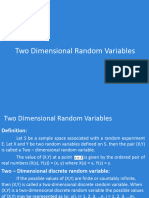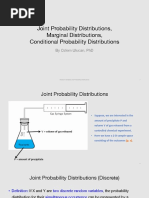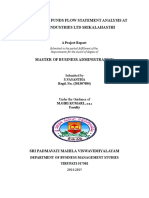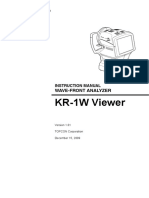Random Variable
Uploaded by
Shubham VishnoiRandom Variable
Uploaded by
Shubham VishnoiMarginal Probability Distributions (Discrete)
Marginal Probability Distribution: the individual probability
distribution of a random variable computed from a joint
distribution.
Problems
1. Three balls are drawn at random without replacement from a box
containing 2 white, 3 red and 4 black balls. If X denotes the number
of white balls drawn and Y denotes the number of red balls drawn,
find the joint probability distribution of (X,Y).
2. For the bivariate probability distribution of (X,Y) given below, find
P(X1), P(Y3), P(X1,Y3), P(X1/Y3), P(Y3/X1) and P(X+Y4).
3. The joint probability mass function of (X,Y) is given by
p(x,y)=k(2x+3y), x=0,1,2;y=1,2,3. Find all the marginal and
conditional probability distributions. Also find the probability
distribution of X + Y.
Y
X
1 2 3 4 5 6
0 0 0 1/32 2/32 2/32 3/32
1 1/16 1/16 1/8 1/8 1/8 1/8
2 1/32 1/32 1/64 1/64 0 2/64
Continuous Joint Distributions
A joint probability density function for the continuous
random variables X and Y, denotes as f
XY
(x,y), satisfies the
following properties:
Continuous Joint Distributions (Example 1)
? ) Pr( ) 2 (
? ) 1 (
. 0
, 1
) , (
2 2
= >
=
s s
=
Y X
c
otherwise
y x f or y cx
y x f
XY
Calculating probabilities from a joint p.d.f.
.
20
3
4
21
) Pr(
.
4
21
,
21
4
) , (
1
0
2
1
1
1
2
2
2
= = >
= = =
} }
} } } }
dydx y x Y X
c c dxdy y cx dxdy y x f
x
x
x
XY
4.The joint pdf of a two dimensional RV (X,Y) is given by f(x,y)= xy
2
+
(x
2
/8), 0x 2, 0 y 1. Compute P(X>1), P(Y<1/2). P(X>1/Y<1/2),
P(Y<1/2/X>1), P(X<Y) and P(X+Y1).
Ans: 19/24, , 5/24, 5/6, 5/19, 58/480, 13/480.
Similar to joint discrete random variables, we can find the
marginal probability distributions of X and Y from the joint
probability distribution.
Compute f
X
(x) and f
Y
(y) in Example
Marginal Probability Distributions(Continuous, Example)
.
2
7
4
21
) , ( ) (
). 1 (
8
21
4
21
) , ( ) (
2
5
2
4 2
1
2
2
y dx y x dx y x f y f
x x dy y x dy y x f x f
y
y
XY Y
x
XY X
= = =
= = =
} }
} }
Independence
In some random experiments, knowledge of the values of X
does not change any of the probabilities associated with the
values for Y.
If two random variables, X and Y are independent, then
. and all for , ) ( ) ( ) , (
ly. respective Y, and X of range in the B and
A sets any for ), Pr( ) Pr( ) Pr(
y x y f x f y x f
B Y A X B Y and A X
Y X XY
=
e e = e e
Covariance
The covariance between two RVs X and Y is
Properties:
). ( ) ( ) ( ))] ( ))( ( [( ) , ( Y E X E XY E Y E Y X E X E y x Cov = =
). , ( ) , ( ) , (
) , ( ) , (
) , ( ) , ( ), , ( ) , (
) ( ) , ( , 0 ) , (
Z Y bCov Z X aCov Z bY aX Cov
Y X Cov b Y a X Cov
Y X abCov bY aX Cov X Y Cov Y X Cov
X Var X X Cov a X Cov
+ = +
= + +
= =
= =
Covariance
Example
Covariance
Example (Cont.)
Covariance
Example (Cont.)
Zero Covariance and Independence
However, in general, if Cov(X,Y)=0, X and Y may not be independent.
Example 10: X is uniformly distributed on [-1,1], Y=X
2
. Then,
Cov(X,Y)= 0, but X determines Y, i.e., X and Y are not independent.
If X and Y are independent, then Cov(X,Y)=0.
. 0 ] [ ] [ ] [ ) , ( So,
. 0
2
1
] [ ] [ , 0
2
1
] [
1
1
3 3
1
1
= =
= = = = =
} }
Y E X E XY E Y X Cov
dx x X E XY E xdx X E
. 0 ) , ( ., . , ] [ ] [ ) ( ) (
) ( ) ( ) , ( ] [
), ( ) ( ) , (
= = =
= =
=
} }
} } } }
Y X Cov e i Y E X E dy y yf dx x xf
dxdy y f x xyf dxdy y x xyf XY E
y f x f y x f
Y X
Y X XY
Y X XY
You might also like
- Joint and Conditional Probability DistributionsNo ratings yetJoint and Conditional Probability Distributions52 pages
- Week 4 - Probability Descriptive Statistics cont (Post-Class)No ratings yetWeek 4 - Probability Descriptive Statistics cont (Post-Class)50 pages
- Unit - III Joint Probability Distribution (Full Notes)100% (2)Unit - III Joint Probability Distribution (Full Notes)30 pages
- Joint Distributions: A Random Variable Is That Maps To NumbersNo ratings yetJoint Distributions: A Random Variable Is That Maps To Numbers37 pages
- 3-Joint Probability Distribution-03-02-2024No ratings yet3-Joint Probability Distribution-03-02-202422 pages
- Chapter5: Joint Probability DistributionsNo ratings yetChapter5: Joint Probability Distributions39 pages
- SDM_UNIT_3_Joint Probability and Markov ChainNo ratings yetSDM_UNIT_3_Joint Probability and Markov Chain7 pages
- Week - 4 - Joint Probability Distributions, Marginal Distributions, Conditional Probability Distributions100% (1)Week - 4 - Joint Probability Distributions, Marginal Distributions, Conditional Probability Distributions21 pages
- DSC6132: Probability and Statistical Modelling: Lecture 4: Multivariate Random VariablesNo ratings yetDSC6132: Probability and Statistical Modelling: Lecture 4: Multivariate Random Variables55 pages
- Student's Solutions Manual and Supplementary Materials for Econometric Analysis of Cross Section and Panel Data, second editionFrom EverandStudent's Solutions Manual and Supplementary Materials for Econometric Analysis of Cross Section and Panel Data, second editionNo ratings yet
- A Study On Funds Flow Statement Analysis at Lanco Industries LTD SrikalahasthiNo ratings yetA Study On Funds Flow Statement Analysis at Lanco Industries LTD Srikalahasthi14 pages
- OTM Debit Mandate Form NACH/ECS/DIRECT DEBIT/SI: HDFC Mutual FundNo ratings yetOTM Debit Mandate Form NACH/ECS/DIRECT DEBIT/SI: HDFC Mutual Fund2 pages
- Auditing SAP R3 - Control Risk AssessmentNo ratings yetAuditing SAP R3 - Control Risk Assessment28 pages
- Introduction To The R Project For Statistical Computing: Stefano CASALEGNO, PH.DNo ratings yetIntroduction To The R Project For Statistical Computing: Stefano CASALEGNO, PH.D25 pages
- CAT 2012 Quantitative Aptitude - The Cyclicity of Remainders - PaGaLGuY News & ChannelsNo ratings yetCAT 2012 Quantitative Aptitude - The Cyclicity of Remainders - PaGaLGuY News & Channels9 pages
- Ewan Withers, Senior It Specialist Business Integration, Emea Websphere Lab ServicesNo ratings yetEwan Withers, Senior It Specialist Business Integration, Emea Websphere Lab Services58 pages
- Marketplace Update: Ensuring Secure Enterprise Blockchain NetworksNo ratings yetMarketplace Update: Ensuring Secure Enterprise Blockchain Networks7 pages
- So, You Want To Learn Artificial Intelligence. Here's How You Do ItNo ratings yetSo, You Want To Learn Artificial Intelligence. Here's How You Do It23 pages
- Axios Systems: Saudi Hollandi Bank ITIL ITSM Case StudyNo ratings yetAxios Systems: Saudi Hollandi Bank ITIL ITSM Case Study2 pages
- Estimation of Concrete Paving Construction Productivity Using Discrete Event SimulationNo ratings yetEstimation of Concrete Paving Construction Productivity Using Discrete Event Simulation14 pages
- Computer Network - CS610 Power Point Slides Lecture 18No ratings yetComputer Network - CS610 Power Point Slides Lecture 1815 pages
- Week 4 - Probability Descriptive Statistics cont (Post-Class)Week 4 - Probability Descriptive Statistics cont (Post-Class)
- Unit - III Joint Probability Distribution (Full Notes)Unit - III Joint Probability Distribution (Full Notes)
- Joint Distributions: A Random Variable Is That Maps To NumbersJoint Distributions: A Random Variable Is That Maps To Numbers
- Week - 4 - Joint Probability Distributions, Marginal Distributions, Conditional Probability DistributionsWeek - 4 - Joint Probability Distributions, Marginal Distributions, Conditional Probability Distributions
- DSC6132: Probability and Statistical Modelling: Lecture 4: Multivariate Random VariablesDSC6132: Probability and Statistical Modelling: Lecture 4: Multivariate Random Variables
- Student's Solutions Manual and Supplementary Materials for Econometric Analysis of Cross Section and Panel Data, second editionFrom EverandStudent's Solutions Manual and Supplementary Materials for Econometric Analysis of Cross Section and Panel Data, second edition
- A Study On Funds Flow Statement Analysis at Lanco Industries LTD SrikalahasthiA Study On Funds Flow Statement Analysis at Lanco Industries LTD Srikalahasthi
- OTM Debit Mandate Form NACH/ECS/DIRECT DEBIT/SI: HDFC Mutual FundOTM Debit Mandate Form NACH/ECS/DIRECT DEBIT/SI: HDFC Mutual Fund
- Introduction To The R Project For Statistical Computing: Stefano CASALEGNO, PH.DIntroduction To The R Project For Statistical Computing: Stefano CASALEGNO, PH.D
- CAT 2012 Quantitative Aptitude - The Cyclicity of Remainders - PaGaLGuY News & ChannelsCAT 2012 Quantitative Aptitude - The Cyclicity of Remainders - PaGaLGuY News & Channels
- Ewan Withers, Senior It Specialist Business Integration, Emea Websphere Lab ServicesEwan Withers, Senior It Specialist Business Integration, Emea Websphere Lab Services
- Marketplace Update: Ensuring Secure Enterprise Blockchain NetworksMarketplace Update: Ensuring Secure Enterprise Blockchain Networks
- So, You Want To Learn Artificial Intelligence. Here's How You Do ItSo, You Want To Learn Artificial Intelligence. Here's How You Do It
- Axios Systems: Saudi Hollandi Bank ITIL ITSM Case StudyAxios Systems: Saudi Hollandi Bank ITIL ITSM Case Study
- Estimation of Concrete Paving Construction Productivity Using Discrete Event SimulationEstimation of Concrete Paving Construction Productivity Using Discrete Event Simulation
- Computer Network - CS610 Power Point Slides Lecture 18Computer Network - CS610 Power Point Slides Lecture 18




